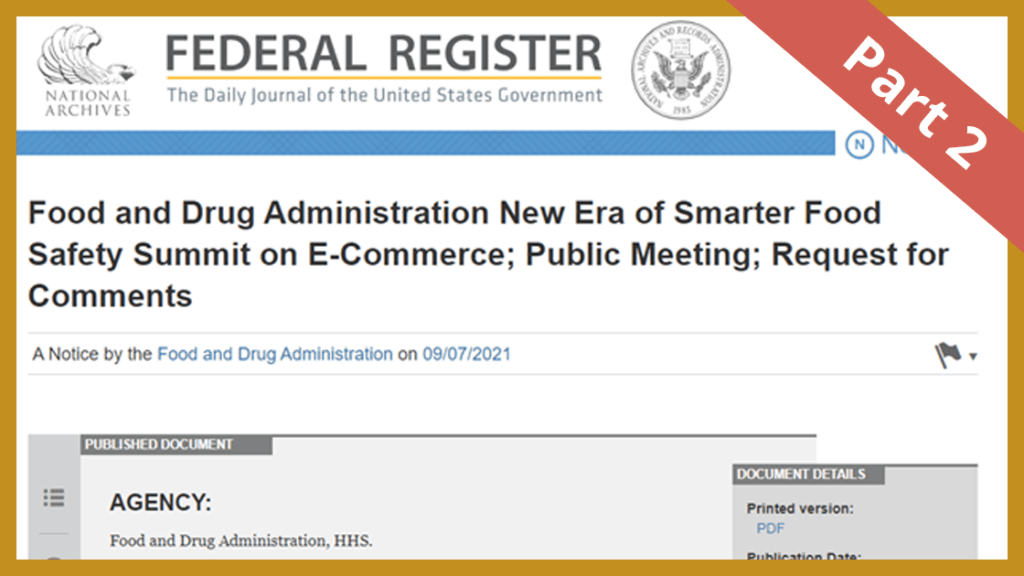What is food e-commerce? What are the food e-commerce vulnerabilities? Below is an excerpt from my Food Fraud Prevention textbook that reviews e-commerce and product fraud risks. This excerpt provides insight for the upcoming US FDA New Era in Smarter Food Safety public meeting on food e-commerce.
Link to the book publisher: https://www.springer.com/us/book/9781493996193?utm_medium=affiliate&utm_source=commission_junction_authors&utm_campaign=3_nsn6445_deeplink_PID9101220&utm_content=deeplink
This is the second blog post in our multi-post series that focuses on the FDA “New Era of Smarter Food Safety” (SFS) blueprint. Other posts will include a review of the FDA public meeting, e-commerce and cybersecurity definitions, a country-level vulnerability assessment, an explanation of supply chain mapping and the use of criminology hot spot analysis, and possibly other topics.
There are new and evolving concerns with product safety and authenticity when dealing with new, different, or more entities storing, transporting, and delivering products. In some cases, there is less risk, and in others, there may be many new variables or vulnerabilities. It is essential to review new vulnerabilities.
To build a foundation of knowledge, it is helpful to conduct a literature review. This excerpt is part of our effort to present some of the concepts.
Excerpt from the Food Fraud Prevention textbook (Spink, 2019):
E-Commerce
A rapidly evolving supply chain innovation is electronic commerce or e-commerce. E-commerce is the use of the Internet, or electronic methods, to conduct sales transactions. The number of mobile phone technology users is booming worldwide, which—when combined with the use of electronic currency (e- currency; e.g., PayPal, ApplePay, SamsungPay, WeChat, QQ, and Bitcoin) and mobile phone application software or “apps”—leads consumers to benefit from the efficiency of ordering online. Whether the app is an online order from a physical retail store or a direct-to-consumer retailer, the consumer is getting more and more products delivered to them rather than picking up the product at a retailer. Depending on the product and the geographic location, the product can be delivered by traditional parcel delivery services (e.g., United Parcel Service UPS, government mail systems, or other rapid delivery such as FedEx or DHL) or local couriers (e.g., bicycle or motorcycle delivery or other more local options). In places like Beijing, China, companies like Amazon.com have their fleet of delivery vehicles such as trucks, tuk-tuks, motorcycles, and bicycles. In areas such as New York City, companies such as Peapod have their truck fleets.
Once consumers get set up and familiar with an e-commerce company or system, the convenience is easy and can even be addicting. Online shopping for clothes or consumer products has boomed as “Black Friday” shopping sales have expanded to include “Cyber Monday.” Another example is the question of why you should get up from your desk and walk to a coffee shop when one clicks on an APP to have a café latte delivered hot to your desk or your park bench. Also, the online ride-ordering services such as Uber and Lyft are providing many new mobile phone features such as being able to see a map of the drivers in your area and to see the wait time until pickup (which is easier than standing curbside waiting to hail a traditional taxi cab but not as easy as walking right up to a taxi stand), there is a safety factor of your location and driver being monitored and recorded, and the transaction is cashless and even physical- interaction- less. So, consumers are becoming more and more confident and reliant on e-commerce. This has benefits but also significant drawbacks for food fraud prevention.
Some food fraud prevention concerns of e-commerce include (Spink 2016, 2017):
- Not knowing exactly where the product is coming from (which could include a continuum from a national delivery service to a local courier).
- Not knowing how the product was handled or mishandled (such as a continuous cold chain or other contaminants).
- Not being able to sample or assess products before purchase.
- There is a lack of clarity on when the product—and legal responsibility—transfer to the end-user (is the courier in contract with the end-user or the seller? Is a trading platform such as Amazon.com, BestBuy.com when facilitating a nonproprietary marketplace transaction, or E-Bay.com, a participant in the transaction with legal responsibility?).
- There is a possible lack of supply chain and handling transparency – including traceability – across the different delivery options (you may order from one e-retailer, and multiple companies may conduct the delivery).
E-commerce is an immense opportunity for the marketplace, companies, and consumers. Still, there will need to be a tremendous amount of research to become aware of the evolving “fraud opportunity.”
Call to Action
The e-commerce term is evolving in the application and narrowing in scope. More transactions occur online, whether for selecting products, ordering, paying, tracking, delivery, and return or disposal. At the same time, the types of projects are getting more detailed in their scope, such as streamlining the “pick-and-pack” of products from retails shelves to storage bins and then into customer vehicles. This chapter section provides an e-commerce overview and concerns that could be included in a food fraud vulnerability assessment (or a food safety risk assessment). Use this insight when you complete or update your food fraud vulnerability assessment for food e-commerce and direct-to-consumer online sales.

